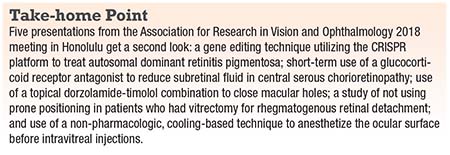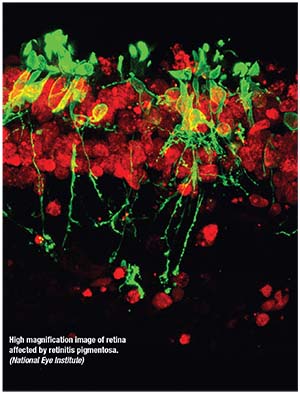The field of retina continues to evolve and advance rapidly through the work of outstanding researchers from the laboratory bench to the bedside. The annual meeting of the Association for Research in Vision and Ophthalmology—ARVO2018—in Honolulu showcased the latest in diagnostics, treatment and
 |
management strategies for retinal disease, while also providing a glimpse into the future of retina with intriguing translational research.
Here, we report on five compelling posters and presentations. They include a novel gene editing technique and delivery modality for a form of autosomal dominant retinitis pigmentosa, oral mifepristone for treatment of central serous chorioretinopathy, topical dorzolamide-timolol for macular holes, vitrectomy without prone positioning for retinal detachment repair, and a novel device for rapid non-pharmacologic anesthesia prior to intra-vitreal injections.
CRISPR-Cas9 Gene Therapy For Retinitis Pigmentosa
Currently, the only approved treatment for retinitis pigmentosa is a retinal prosthesis for patients with profound vision loss. RHO is the most common gene involved in autosomal dominant RP (ADRP). CRISPR-Cas9—CRISPR stands for clustered regularly interspaced short palindromic repeats, and Cas9 for CRISPR-associated system9—is a gene-editing technique that relies on a guide RNA that can be programmed to target different genomic loci.
In this study, the researchers
 |
successfully utilized CRISPR-Cas9 to target and edit out the human RHO gene responsible for this form of ADRP in human embryonic kidney (HEK293) cells.1 Importantly, the researchers were able to effectively deliver the CRISPR-Cas9 ribonucleoprotein complex using a lipid nanoparticle. They then used polymerase chain reaction to confirm that the RHO gene was successfully silenced.
This is the first study to demonstrate the effective use of nanoparticles (instead of viral vectors) transfected with CRISPR-Cas9 for gene editing of a retinal disease. This gene editing technique allows for disruption of both normal and mutated alleles of the RHO gene, which is critical for effective treatment of ADRP. The results provide a promising step forward in finding a potential treatment for a common form of RP.
Mifepristone for Central Serous Chorioretinopathy
The short-term use of oral mifepristone, a glucocorticoid receptor (GR-2) antagonist with high oral bioavailability, may reduce subretinal fluid and improve vision in patients with central serous chorioretinopathy (CSC). CSC is associated with elevated serum cortisol levels. Mifepristone antagonizes cortisol action competitively at the glucocorticoid receptor level.
In this randomized, double-masked, multi-site, placebo-controlled trial, 30 patients with chronic and/or recurrent CSC were randomized into three groups:2
mifepristone 300-mg daily for four weeks;
mifepristone 900-mg daily for four weeks; and
placebo for four weeks.
After dosing, all patients were followed for four weeks for observation. After eight weeks, the researchers noted a statistically significant reduction of central retinal thickness (CRT) of 82 µm (p<0.05) and improvement in best-corrected visual acuity of 3.6 letters (p<0.05) in the treatment
 |
groups.
Patients that received placebo did not have a significant change in CRT (47 µm, p=0.45) or BCVA (0.7 letters, p=0.64). However, neither the change in CRT (p=0.15) nor change in BCVA (p=0.19) achieved a statistically significant difference between the two treatment groups.
The authors reported that mifepristone was well tolerated in the trial. Larger studies are warranted to further investigate the safety and efficacy of this medication in CSC, but mifepristone appears to be a promising new agent that can be added to our armamentarium for the treatment of chronic and/or
recurrent CSC.
Topical Dorzolamide-Timolol For Macular Holes
Hydration of retinal tissue may play a significant role in macular hole formation. Topical dorzolamide-timolol may assist in the closure of some macular holes through cystoid dehydration. In this study, a series of four patients with idiopathic full-thickness macular holes received twice-daily topical dorzolamide-timolol. All included holes were less than 300 µm in diameter.3
Two of the four holes closed spontaneously after four weeks of topical dorzolamide-timolol and had associated improvement in vision. Both eyes remained stable, and the holes remained closed after six months of follow-up. Larger, controlled studies will be useful to validate the possible role of cystoid dehydration with topical dorzolamide-timolol in the closure of full-thickness macular holes.
Vitrectomy Without Prone Positioning for RRD
Prone positioning after pars plana vitrectomy (PPV) is often quite challenging for the recovering postoperative patient. Previous studies have demonstrated that PPV for macular holes without postoperative prone positioning had excellent closure rates. In this study, the authors demonstrated that PPV without prone positioning was associated with a higher reattachment rate in eyes with a rhegmatogenous retinal detachment (RRD), particularly those with inferior retinal breaks.4
This retrospective cohort study included 142 eyes with a primary RRD. All patients underwent PPV with 20% sulfur hexafluoride gas tamponade. All phakic patients received simultaneous cataract surgery. The patients were then divided into two groups: Those who were advised to maintain prone positioning, and those who were not. The patients who were advised not to maintain prone positioning were instructed to sleep in a supine position. All patients were followed for more than three months.
Of the 142 eyes, 65 underwent postoperative prone positioning and 77 went without prone positioning. The initial reattachment rate was 96.1 percent in the group without prone positioning vs, 83.1 percent in the prone-positioning group. The authors noted this difference was statistically significant (p=0.011).
In RRDs without inferior breaks, the initial reattachment rate was similar in both positioning groups. In RRDs with inferior breaks, the initial reattachment rate was significantly higher without prone positioning (94.7 percent vs. 60 percent with prone positioning, p=0.036). Despite the higher overall reattachment rate, patients that did not perform prone positioning had a higher incidence of epiretinal membrane (ERM), although it did not achieve statistical significance (17.8 percent vs. 4.9 percent, p=0.092).
This study demonstrates that maintaining a strict prone position may not be a requirement after PPV for RRD in pseudophakic eyes. The data may convince more surgeons to liberate their patients from the burdensome requirement of postoperative prone positioning, even in those with inferior breaks. However, the increased possibility of ERM in these patients may influence the surgeon’s positioning recommendations.
Non-pharmacologic Anesthesia for IVT
A novel non-pharmacologic, cooling-based method for providing ultra-rapid anesthesia before intravitreal injection (IVT) was well tolerated when compared to lidocaine-based anesthesia. The portable, handheld device utilizes thermoelectric cooling to rapidly anesthetize a 4-mm-by-4-mm area on the surface of the eye before the injection.
This randomized, prospective, unmasked clinical trial included 20 patients who were receiving bilateral IVT for either neovascular age-related macular degeneration or diabetic macular edema.5 One eye was randomized to lidocaine-based anesthesia (3.5% lidocaine gel), while the fellow eye received ultra-rapid, non-pharmacologic anesthesia.
Subjective pain was assessed at the time of IVT and four hours afterward, and responses were recorded via visual analog scale (from 1 to 10). Subjective pain scores at the time of injection were 2.9 ±0.47 for subjects receiving topical lidocaine, and 2.7 ±0.41 in the treatment group (p=0.7, mean ± standard error of mean [SEM]). Postinjection pain scores were 1.7 ±0.5 for topical lidocaine and 1.5 ±0.43 in the treatment arm (p=0.7, mean ±SEM).
Ultra-rapid cooling for non-pharmacologic anesthesia demonstrated similar patient-reported pain scores when compared to anesthesia with topical lidocaine gel. This anesthesia device may someday offer a more efficient and tolerable injection procedure for both patients and physicians. RS
REFERENCES
1. Arbabi A, Spee C, Hinton DR, et al. CRISPR-Cas9 RNP complex, delivered via lipid nanoparticle, is effective in disruption of RHO gene in vitro. Poster #26–A0057 presented at Association for Research in Vision and Ophthalmology; April 29, 2018; Honolulu, HI.
2. Goldberg RA, Heier JS. Short-term oral mifepristone for the treatment of central serous chorioretinopathy (STOMP CSC)—a randomized, placebo-controlled study. Abstract #782 presented at Association for Research in Vision and Ophthalmology; April 29, 2018; Honolulu, HI.
3. Su D, Obeid A, Hsu J. Topical aqueous suppression and spontaneous closure of idiopathic full-thickness macular holes. Poster #866–A0198 presented at Association for Research in Vision and Ophthalmology; April 29, 2018; Honolulu, HI.
4. Sakimoto S, Shiraki N, Sakaguchi H, Nishida K, Nishida K. Vitrectomy without prone positioning for rhegmatogenous retinal detachments in eyes with inferior retinal breaks. Poster #861–A0193 presented at Association for Research in Vision and Ophthalmology; April 29, 2018; Honolulu, HI.
5. Besirli CG, Smith S, Pipe K, et al. Clinical feasibility of ultra-rapid non-pharmacologic anesthesia for intravitreal injection in patients receiving anti-VEGF treatment. Abstract #1618 presented at Association for Research in Vision and Ophthalmology; April 30, 2018; Honolulu, HI.



